Case Study: 63,256 Calls Boiled Down to the Most Effective Web Lead Follow-up Strategies
In this article, we take a deep dive into the most-effective strategies for making phone contact with web-lead submissions. Read on for the full details of our in-depth case study or skip ahead to the key findings for simple steps you can take to double your contact success and qualification rates.

You know what’s the worst? Cold-calls.
It’s the same formula every time: An unsolicited call from a breathless salesperson just praying you spare him the 10 or 15 seconds he needs to spill out his canned pitch. Nothing worse than that. Well, other than having to be the unfortunate soul making the cold-call.
No-call lists haven’t entirely killed off the cold-call beast, of course. But with any luck, the trend towards warm-call marketing to web generated leads will one day finish the job. The marketing automation software provider, Marketo, recently reported that as many as 93% of B2B buyers now begin their purchasing process with a web search.
The irony is that many of the same issues that haunted cold-calling still apply to warm lead phone follow-up. Even with an open invitation, it can be tough to get contacts on the phone. And, the pressure to quickly and effectively communicate the value of your services is still very real.
If you’re struggling to connect with web lead contacts, you’re not alone. On average, 80% of B2B sales calls end up in voicemail and over 90% of voicemails go unreturned according to numbers from the sales data verification service, RingLead.
What can you do to be more effective at reaching web submission contacts? Quite a bit as it turns out.
Cold-calling is a grind-it-out, quantity-based approach. Call volume matters with web leads too, but calling warmer web prospects offers some smarter-not-harder shortcuts.
Recently, we gathered data about web lead follow-up that was too interesting to keep under our hats. Having parsed over 60,000 calls worth of data, poked and prodded it, and implemented the best practices it pointed toward, we figured, “Why not share what we found?”
Our Key Findings Include the Following:
- Waiting to call web leads ruins contact and qualification rates. Delaying follow-up will ultimately minimize your sales prospects and inflate your cost-per-conversion.
- Most salespeople give up far too quickly. Doubling your per lead qualification rate requires 10 calls on average.
- Mornings are slightly more effective for making follow-up calls to web contacts.
- If you have to choose certain days for follow-up, the middle of the week is the best time.
Look, there’s no shortage of online articles proclaiming they’ve found the silver bullet for lead calling success. We’re as dubious about them as you probably are. Perhaps you’re wondering if this is one.
We get it. We like to see the math too. What follows is our best attempt to “show the work.” We think it’s an equation that shows how any business can multiply their web-lead follow-up success.
Laying the Groundwork for Improved Contact Rates
In May of 2014, we introduced a new piece of internal software. At first glance, it doesn’t look like much. It has one screen. It has no settings. It offers only a single button. But it serves a critical purpose: It alerts our interview team the second a visitor to our website submits a request, allowing us to immediately reach out to them.
While we’ve always been pretty quick with our follow-up, it turns out that a giant, flashing red siren has a certain way of really kicking things into gear. Go figure.
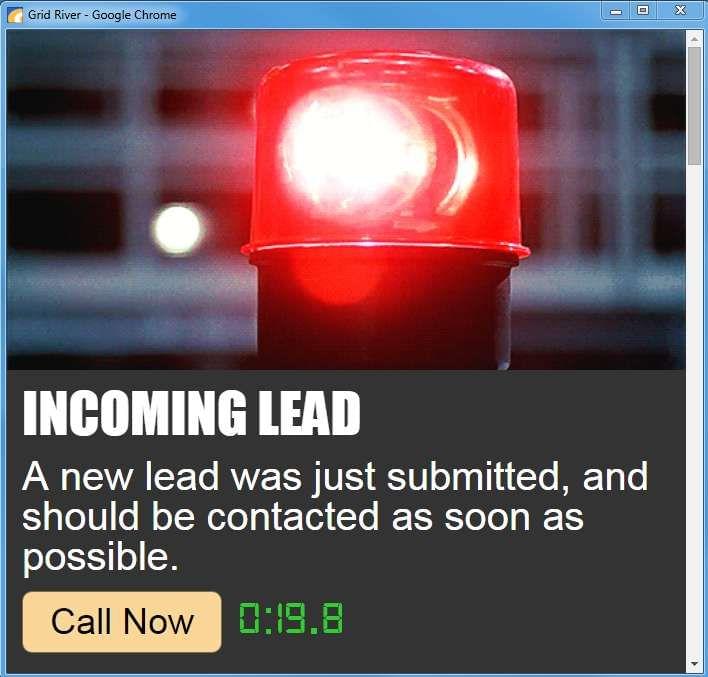
Before we implemented our alert system, we already knew waiting the industry average of 46 hours to contact online inquiries was way too slow. (For more interesting stats on lead follow-up, check out the full article over at Forbes from InsideSales.com CEO, Ken Krogue.) But once we had the notification software in place, we were able to see exactly how wasteful delaying follow-up is.
How Does the Speed of Follow-Up Affect the Results?
When we launched our alert system, we started with a simple premise: The best way to get in touch with someone who has submitted a web request is to reach out to them right away.
Here’s specifically why we felt it was a reasonable assumption make: By submitting a web request, the “prospect,” “lead,” or “prospective buyer” (whichever term you prefer) is communicating their interest. Once they’ve requested follow-up, what better time to contact them than when their request is still fresh in their mind? And, isn’t this the time they are most likely available to take a call?
We also reasoned that the more time elapses, the larger the chance the prospect might find an alternate source to meet their needs or decide to focus on other priorities.
Working through the logic in favor of quick follow-up isn’t exactly rocket science. And, not surprisingly, there is published research that independently verifies the value of quick outreach. In fact, the data suggests that modern business buyers not only want, but expect fast follow-up.
A study by the research firm Zogby Analytics revealed that “60% of buyers said they would begin to question a company’s attentiveness if they did not hear back from the company within 24 hours after submitting an online firm.”
It’s one thing for a prospect to “question attentiveness,” but does speed of follow-up truly affect vendor preference? B2B buyers say it does. 72% of business buyers from the same Zogby study said that the first company to contact them had “an advantage over the competition.”
So based on the research and simple common sense, we expected to see a positive correlation between quick outreach and improved contact rates. But we were still surprised by how profound the impact of tightening outreach times could be was when we looked at our actual numbers.
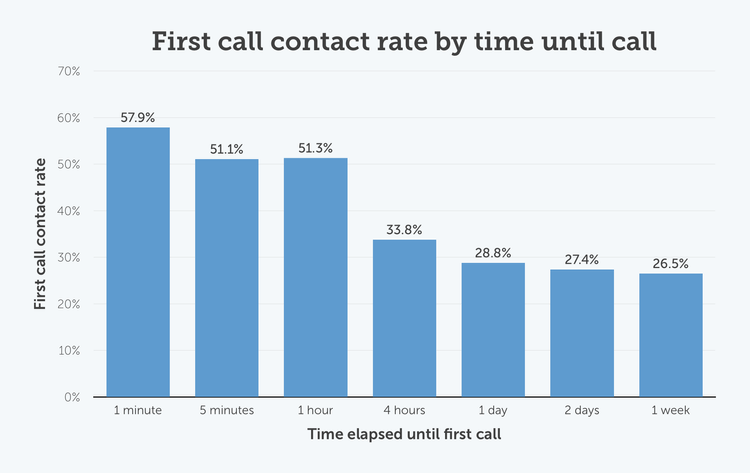
In our case, following up within a minute doubled the number of contacts we were able to reach, when comparing it to those we waited a day to follow up with. So, yes, when we saw this data, it definitely was one of those, “Holy smokes, we’re going to have to make some changes,” moments that really good BI data can occasionally serve up.
Exciting as the data was, we had one concern. Was it possible that speeding up outreach might mean we could talk to a larger amount of people, but qualify a smaller number of them? Would some people be turned off by the quick follow up?
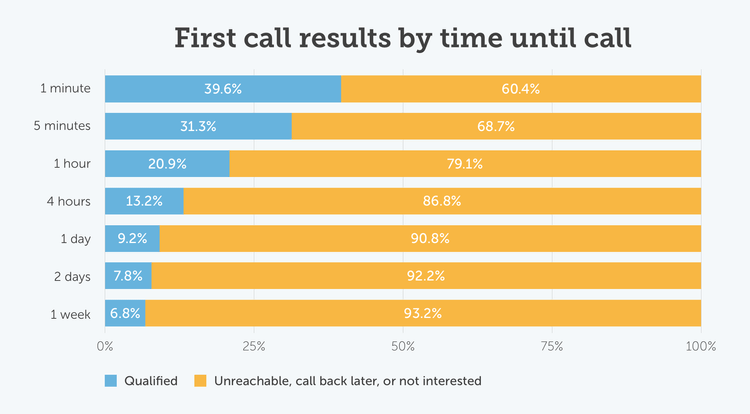
The data again gave us a clear answer. Calling contacts quicker was definitely not a turn-off. In fact, the quicker we called, the better our qualification rate.
We qualified nearly twice as many prospects (39.6% versus 20.9%), just by picking up the phone immediately versus waiting an hour.
Perhaps the easiest way to visualize the efficiency impact of calling web prospects quickly is to look at the difference in the number of calls required to qualify a lead based on when we made the first call. In terms of calling efficiency, reaching out right away provides a huge win.
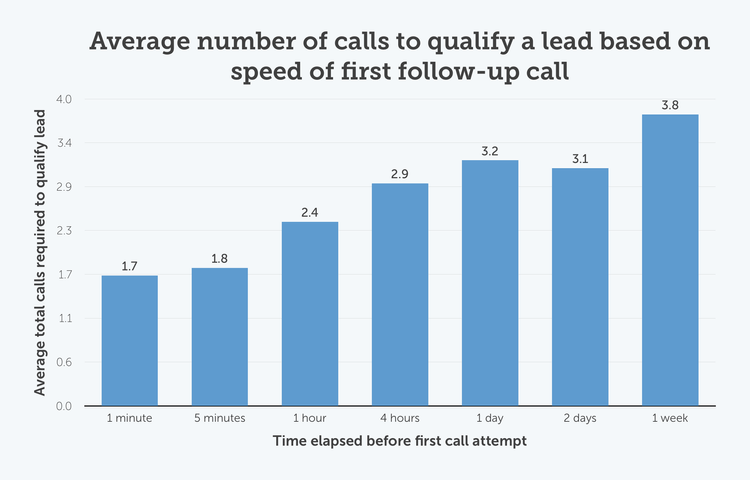
How Many Follow Up Calls Should Be Made?
Here’s a potentially sticky situation: You’ve tried reaching out a couple of times to a prospect, but you haven’t been able to get in touch. Do you continue to call?
Everybody wants to succeed at their jobs. Nobody wants to be a pest. But there you are caught in the classic salesman’s dilemma.
Let’s flesh out this scenario a little bit. Assume the following:
- The contact initiated the communication, shared their contact info, and requested your follow-up.
- Your website or lead source has made it clear to the contact you’ll reach out by phone.
- Any follow-up emails you’ve sent offered an easy opt-out or unsubscribe option.
- You’ve already invested time preparing yourself by reviewing any info the contact has provided about their needs.
- And, not least of all, you’re a reasonable human being! If your contact isn’t interested, that’s fine–you’d just like to know.
If you’ve checked off each of these boxes, I have a hard time concluding anything other than that you’ve approached the situation with courtesy and reasonable expectations.
The more important question at this point is, “Is it worth it to make another call?”
It’s a tricky one. “Worth” is a relative thing and contexts change. One day, you’re flush with opportunities to follow-up on and the next day, not so much.
Be that as it may, what we found out when we studied our own data was that there is a steep price to pay for cutting short follow-up. Qualified prospects will be lost–and lost in significant numbers.
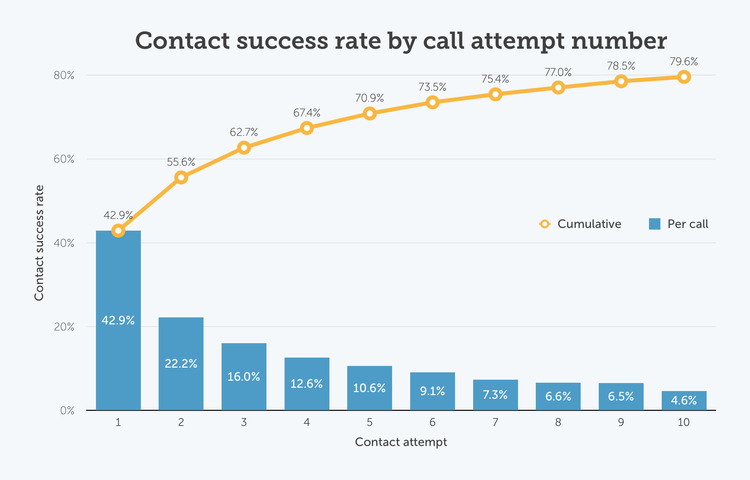
Earlier, we documented how decreasing the wait time between submission and follow-up created a positive effect on our contact and qualification rates. But regardless of fast or how slow follow-up occurs, statistically the first call is your best bet to get someone on the line.
We found that we spoke to almost twice as many contacts on our first call as on our second (42.9% versus 22.2%). From there, the per call contact rates drop off. By the time we reached the 10th call, we were down to less than 1 in 20 individual calls resulting in conversations.
Admittedly, it is hard to get excited about a per call contact rate under 5%. But the cost of making an additional call is cheap (maybe 30-60 seconds). More importantly, over time the contact numbers add up. We discovered that continuing through the 10th call increased our overall contact rate to nearly 80%–almost doubling the contact rate resulting from calling just a single time.
Of course, trying to find a salesperson who’d admit they make only one call to leads and move on is probably about as productive as looking for a politician eager to claim they raised your taxes. But guess what& The tax code still gets longer every year, and research shows that the average number of calls sales reps make before giving up is only 1.3. That’s far too few calls, if you want to make effective use of your web leads.
Just by not giving up, we were not only able to increase our contact rates, but also our qualification rates. Take a look.
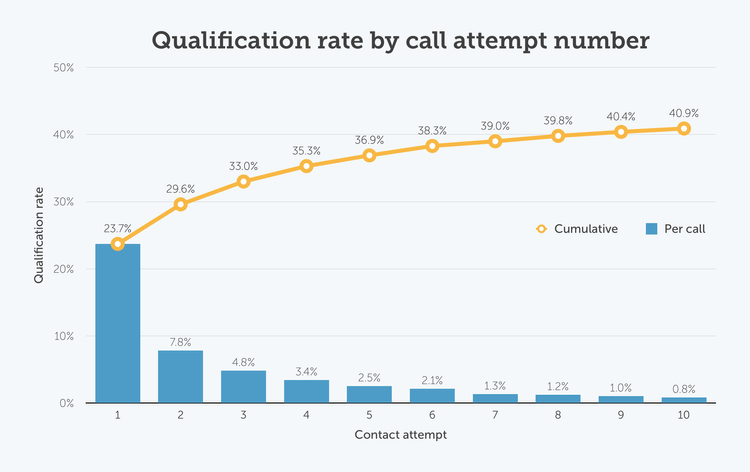
Similar to what we saw with contact rates, we nearly doubled our qualification rate by continuing to reach out through the 10th call attempt. By this point in our follow-up, we’ve essentially the flattened the parabola that represents the increase in overall qualification rate. Having done so, we can move on without wondering what kind of opportunity cost we sacrificed by doing so.
What Effect Does Time of Day Have on Contact Rates?
There are times of the day where it is easier to reach leads.
That’s the headline most articles on the topic start with. We found the same thing, too. But it’s important to emphasize a couple of caveats.
First, the difference in the effect of time of day for calls is fairly minimal.
Second, if you don’t correct for some variables, the data can be a bit misleading.
Let’s start first with contact rates broken down by the hour of the day, relative to the average contact rate.
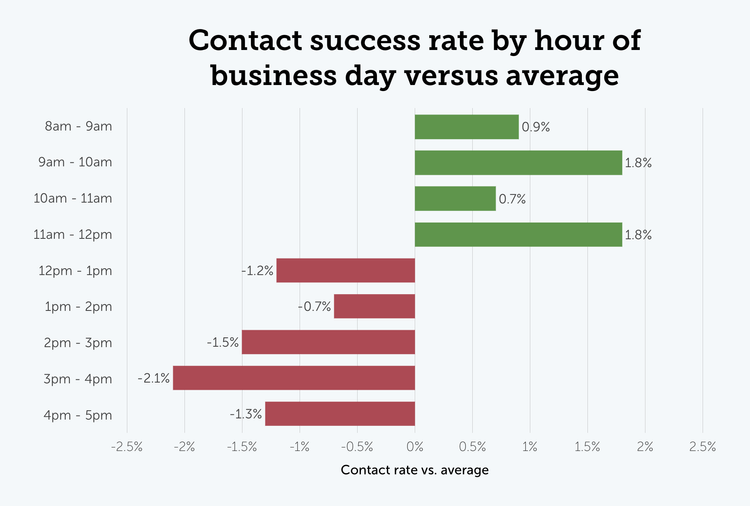
There’s a clear pattern visible in the data. Morning hours come out ahead.
But there’s an important variable in play that might be a bit misleading.
The fact is, we generally don’t call leads outside of standard 8am – 5pm hours. What happens when a visitor to our site submits a web inquiry during “off hours”? We call it as soon as we can the following morning. Basically, by virtue of maintaining standard office hours, we end up making a disproportionate number of first call attempts in the morning. Since first calls result in high contact rates, the morning numbers get a bit of a bump.
What we’re really interested in finding out is when contacts are most receptive. To normalize data, consider the following data set which excludes leads submitted outside of standard business hours:
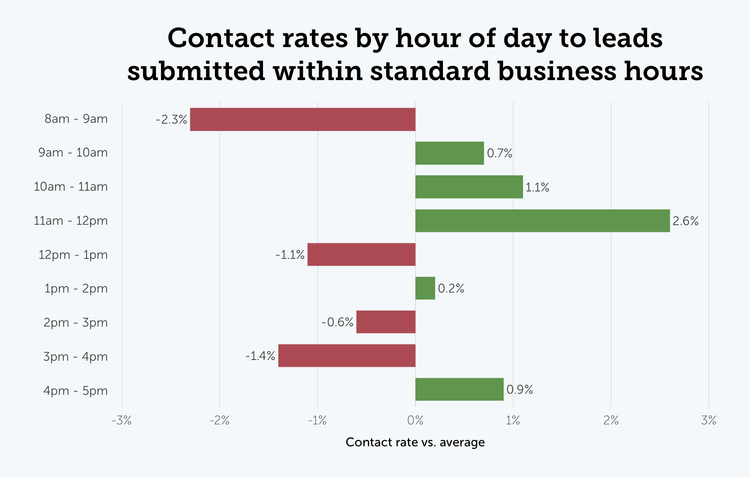
Looking at the adjusted data, call outcomes did vary by time of the day, but the variance was relatively mild.
Mornings still emerged as the most effective time for us to make contact–with the notable exception of 8am to 9am calls. And, the 4pm hour at the end of the business day also yields above average contact rates.
But looking at the effect of time of the day, it doesn’t appear there’s that much meat on this particular analytical bone. How quickly you call leads and how many attempts you make will have a far greater effect on your follow-up success than when you call leads.
Which Days of the Week Are the Best for Follow-Up?
We call leads every weekday. That won’t ever change. As a software matching service, qualifying prospects and matching appropriate solutions is an everyday proposition.
But many salespeople need reserve particular days for contact follow-up and others for other sales and account management activity. In these cases, it’s beneficial to have an understanding of which days yield better contact rates.
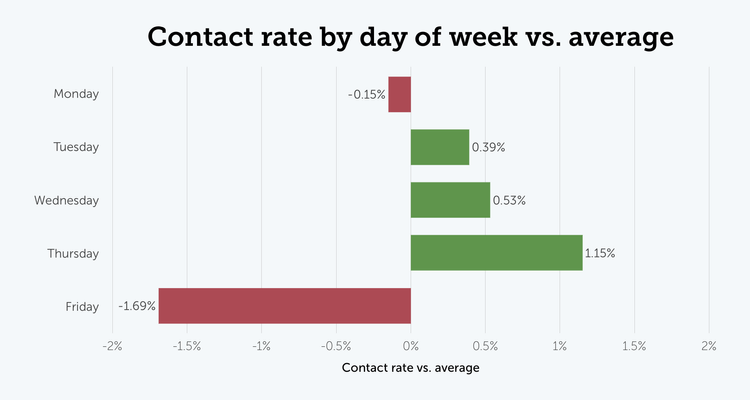
Our data points to the middle of the week as the best time to contact leads, with Thursday as the strongest individual day and Friday as the weakest. But again the variance is fairly mild. Over thousands of leads, the trend is visible, but over a smaller number, it’s unlikely to be a trend pronounced enough to arrange a schedule around.
Adapting to the Data
Optimizing lead outreach is part art and part science. The ability to quickly establish rapport with leads, identify the most compelling value proposition for each unique contact, and communicate persuasively with selective buyers requires tact and expertise.
But amid the more subjective factors involved in making the most of your prospect follow-up, there are some objective steps you can take. Having sorted through the data searching for repeatable and quantifiable steps, we’re confident we’ve found two of the most important factors. Following up immediately and sticking with leads despite early failures to connect both allow us to qualify a considerably larger number of prospects than we otherwise would be able to.
Numbers are great, but they don’t mean much without acting on them. In our case, we’ve enacted a number of process changes–starting with our internal lead alert software–to increase the effectiveness of our outreach. One measure of the progress can be seen in our follow up times. Over the past year, if you calculate our average follow-up time, we’ve been able to get it down to within 3 minutes. More than half the prospects who request follow-up on our site will now hear their phone ring within 1 minute.
Additionally, we’ve extended our commitment to decreasing the delay that prospects experience beyond ourselves. Just recently, we halved the time it takes to make software matches between buyers and sellers, by updating our system to conduct software matching twice daily instead of just once. In fact, with the assistance of our faster-acting software provider partners, we’re now able to refer some buyers to their top software recommendation within just minutes.
Summary
How Does the Speed of Follow-Up Affect the Results?
The quicker we called contacts the more likely we were to speak with them and successfully qualify their interest. Calling within 1 minute of lead submission doubled our first call successful contact and qualification rates.
How Many Calls Should Be Attempted?
Calling contacts a full 10 attempts lead to nearly twice as many qualified leads versus calling only once. Research shows the average number of call attempts salespeople make to inbound leads is 1.3–far too few to maximize contact.
What Is the Best Time of the Day to Call Leads?
We generally experienced the most success calling leads in the morning hours. However, the time of the day of call attempts had a relatively minor influence on lead contact. The difference in contact rates for the best and worst hours of the day was less than 5%.
What Is the Best Day of the Week to Call Leads?
The middle of the week (T-Th) is a slightly more effective time to reach out to lead contacts. Calls on Thursday had the highest contact rate. But day of the week is even less of a factor than time of the day on lead follow-up success. The difference in contact rate between the best day (Thursday) and the worst (Friday), was less than 3%.
_Looking for more ideas on optimizing your lead follow-up? Check out study author Adam Bluemner’s recent visit with host Jim Obermayer on the Sales Lead Management Association (SLMA) Radio Program: “Listen While You Work: A study on the Most Effective Lead Follow-Up Strategies”.
